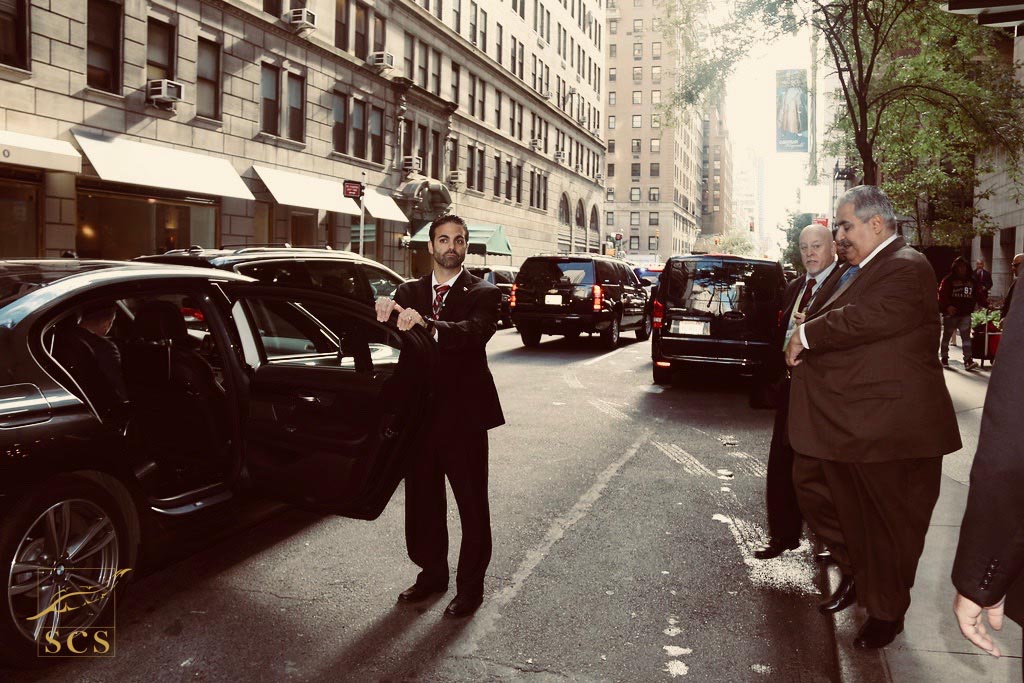The close protection industry is complex and challenging. And yet, from an outside perspective, everything seems pretty simple. Almost everyone associates close protection professionals with the people they see in the headlines, next to the celebrities that they are supposed to be guarding.
Tall, wearing expensive suits and sunglasses – despite it being night outside, they stand next to their clients and look menacing. Right? Well, no, not at all. EP/CP agents are competent, well-trained, and experienced individuals.
The services they provide are many and varied – and often very specialized. Most people think that they know who guards the Prime Minister of Britain – since they’ve seen him with his security quite often. In fact, they often don’t know what his Personal Protection Operative looks like – despite probably seeing his face on TV a number of times.
This is why it’s so important to know:
- what close protection services are and what they are not,
- how a close protection detail is organized and structured, and,
- how to manage your expectations when employing a close protection detail.
Close Protection Details
Firstly, you should know that a “close protection detail” can refer to two agents or more. Expectedly, a single person provides a certain degree of protection that may be limited in some settings. However, this is not necessarily a sign of sub-par service, rather it’s something that depends on factors like the principal’s threat level and budget.
A single operative is then the driver, mechanic, personal bodyguard, and general security adviser. On the other side of the extreme, a detail can consist of around 10 people – with certain functions being doubled or even tripled in order to factor in things like shift changes. The advance team can typically consist of two persons and the CP team of two individuals.
These types of details are usually what we find in military or governmental close protection, but also sometimes in the private sector as well. Certain royal families from the Middle East employ details of over 30.
Team Structure
Generally, a close protection operative is anyone involved in the protection of the principal, regardless of their specific function. However, a full CP detail consists of individuals performing very specific roles.
Team Leader – TL
The Team Leader’s role is to manage the detail and communications with the client. Note that the client is usually the person or entity employing and paying for the services of the close protection detail, while the principal is the person who’s being protected – the protectee.
The TL’s position requires experience and intimate knowledge of the industry and the principal in order for them to ensure that operation runs smoothly and efficiently.
Second in Command – 2IC
The Second in Command acts as a depute detail leader and assists the TL in bigger operations. Also, it is the 2IC’s duty to step in for the TL when they are absent.
A 2 IC can also act as QM – quartermaster, should the situation require it.
Personal Protection Operative or Agent in Charge
Simply put, the Personal Protection Operative’s job is to protect the principal – but the exact role can vary from detail to detail and from principal to principal. They are part of the inner cordon of protection and should the outer cordon be compromised, the PPO is there to remove the principal from that situation.
Therefore, the PPO needs to be experienced and inspire confidence and trust in the principal. Otherwise, the Principal could question their decisions or instructions at a critical time, which can be very detrimental for their safety.
Also, a wide variety of close protection operatives are tasked with this role. It puts them “front and center” and allows them to get comfortable spending time and communicating with the principal.
Personal Escort Section – PES
These are the detail members that provide and maintain a safe area around the principal – also known as the outer cordon. It’s the job of the PES to constantly look for threats or any signs of suspicious activity. Because of this, they are usually positioned in such a way as to provide 360-cover around the principal. Furthermore, this is common among principals needing to navigate large crowds.
A well-trained PES detail always adapts to any environment or situation, moving seamlessly around the principal in open spaces, as well as crowds. Those lacking in experience – or simply bad operatives, tend to stick out due to poor positioning.
However, sometimes the PES sticks out intentionally and this is not because they are bad at their jobs or inexperienced. Rather, operating overtly is desirable in certain situations – such as guarding a high-profile Government official in a hostile environment.

Security Advance Team – SAP
The SAT or simply, the Advance Team, is always one tactical step in front of the PES, PPO, and the Principal. Their main function is to make sure that the routes and venues are clear and secure. This includes:
- Entrances and exits,
- Routes between venues, and,
- Emergency routes.
For example, if the SAT is checking out a local hospital, they will make sure that the hospital has emergency and useful exits to allow for a smooth, low-profile entry, as well as the distance from the police station or a specific embassy. The detail times and documents every move, relaying it to the Team Leader.
In addition, the SAT contributes to convenience also, including pre-identifying rooms of importance, as well as the restroom.
This way, the incoming detail is equipped with all the necessary knowledge to ensure the principal’s safety at every moment during movement.
Residential Security Team – RST
This is the detail charged with the daily security at the principal’s residence – or properties and offices. The RST does this by maintaining access control for any persons or deliverables to the property. Therefore, the residential security detail:
- Inspects all vehicles and visitors coming in and out;
- Prevents the introduction of explosive devices, electronic bugs and unwelcome calls; and,
- Secures all means of entry.
Additional roles
Security Driver – an individual trained in advance driving skills, also responsible for vehicle checks as well as maintenance.
Medic – a medical practitioner there to provide immediate treatment to the principal and other members of the detail.
Personal Security Detail – PSD operatives have extensive weapon-handling skills and training and specialize in environments to which the principal travels.
Conclusion
In this challenging and volatile world, the need for close protection is becoming increasingly important. However, in order for it to be effective clients and principals need to understand the specific roles and functions that every member of the detail performs.
On the other hand, due to the complexity of those tasks and duties, CPOs require years of experience and expertise from within the security services industry. Details need to be highly trained in order to properly assess your logistical requirements. In addition, they need to deploy the measures to ensure you can go about your business, safely and efficiently.
Companies like SCS make it their business to safeguard you to the point where you genuinely feel protected and free to grapple with your busy day – all under our EP detail’s watchful eye.

